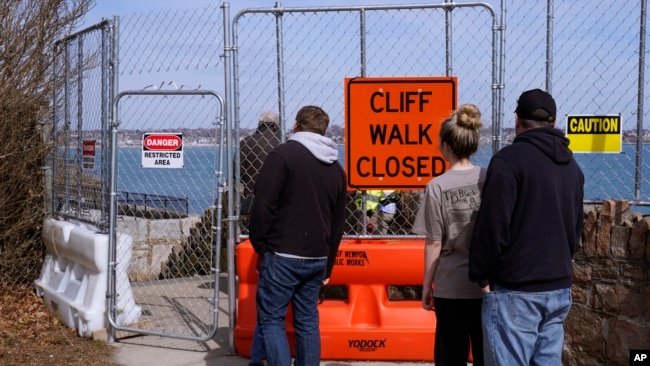
Public Services Director Bill Riccio look down at the destruction along the historic Cliff Walk on March 15, 2022 in Newport, Rhode Island. (AP Photo/Charles Krupa)
Leaders in the northeastern American city of Newport, Rhode Island, are facing a difficult question: Should the city continue to rebuild its famous Cliff Walk?
The question is a hard one because parts of the wall keep falling into the sea. Last week, coastal erosion caused nine meters of the path to break into the sea below. Erosion is the slow destruction of something by natural force.
The Cliff Walk is one of the most popular places to visit in Rhode Island. It is a central part of Newport’s identity. It offers visitors beautiful views of Rhode Island’s coastal environment. The five-kilometer path travels next to huge costly homes that sit high above the rocky coastline.
A 2018 study found that about 1.3 million people visit the Cliff Walk each year.

In 2012, a powerful ocean storm washed out parts of the path. The path was repaired then at a cost of $5 million in federal money. But city officials are questioning if they should rebuild this time — or move it farther inland.
City official Joe Nicholson says he wants to rebuild. He is asking Rhode Island’s governor and congressional officials to help.
Like most locals, he has walked the path many times. “It’s something that’s in Newport’s DNA,” Nicholson said.
He does not know how long repairs could take, or how much it might cost. It will not be done in time for the arrival of summer visitors. Engineers came on March 15 to begin examining the damaged area.
The part of the path that recently collapsed is next to private property. So, the path cannot be moved inland there anymore.
John Greichen Jr. lives less than two kilometers away from the path. He says friends from different areas always want to visit the path.
“Everyone knows when they come to Newport, they’ve got to do the Cliff Walk,” he said.

Climate change and the collapse
Scientists say climate change may have created the conditions that led to the collapse.
Michael Mann is the director of the Earth System Science Center at Pennsylvania State University. He said that larger storms that happen more often can combine with sea level rise to increase the threat of erosion. That can lead to a collapse.
“We are now seeing the devastating consequences of climate change playing out in real time,” Mann said in an email to The Associated Press.
In February, the National Oceanic and Atmospheric Administration (NOAA) and six other agencies issued a report about sea level rise in the United States. The report warned that America’s coastline will see sea levels rise in the next 30 years by as much as they did in the whole 20th century.
NOAA said Newport has seen a sea level rise of about 15 centimeters over the past 50 years. Scientists estimate sea levels are expected to rise another 25-30 centimeters in the next 30 years.
I’m Gregory Stachel.
Jennifer McDermott reported this story for The Associated Press. Gregory Stachel adapted it for VOA Learning English.
______________________________________________________________
Words in This Story
cliff – n. a high, steep surface of rock, earth, or ice
erosion – n. the gradual destruction of something by natural forces (such as water, wind, or ice)
devastating – adj. causing great damage or harm
consequence – n. something that happens as a result of a particular action or set of conditions
We want to hear from you. Write to us in the Comments section, and visit WWW.VOA-STORY.COM